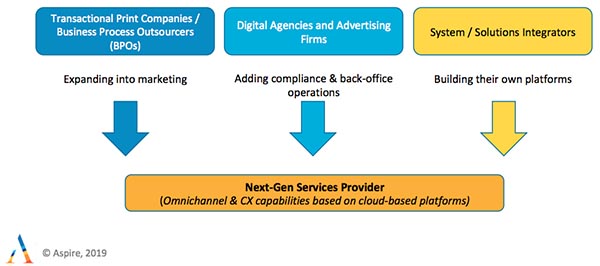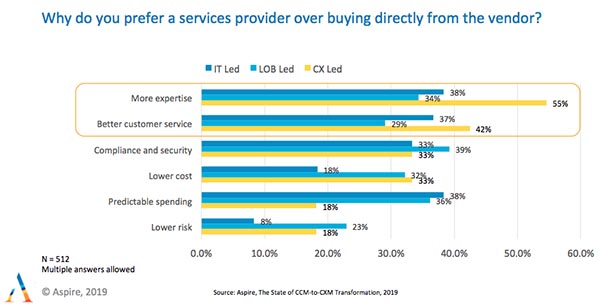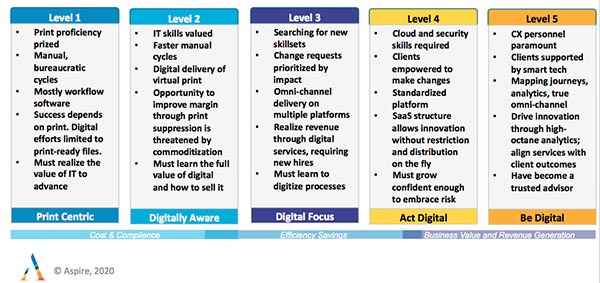As we enter the third decade of the 21st century, the Customer Communications Management (CCM) market is undergoing radical changes on an evolutionary scale. In order to better understand the forces behind this evolution, late last year, Aspire CCS, surveyed businesses across the globe, interviewed stakeholders in every facet of the market, and published an extensive report entitled, “The State of CCM-to-CXM Transformation.”
This, the second in a four part seriespublished in partnership with WhatTheyThink,will focus on customer communications service providers’ place in the emerging ecosystem by examining the five steps to CXM maturity and explaining how providers can upgrade their technology and strategy to move up the scale, ensuring their long-term viability. In the previous installment, we established that, for the majority of enterprises, the needs of the business have surpassed cost savings as the primary factor influencing investment. Instead, the focus is now on owning communications so that they can respond more quickly to changes in the market, can support emerging channels, and can provide more relevant communications to their customers. We are now moving toward that next evolutionary step, where businesses begin to adopt a perspective that looks from the outside in, allowing actual consumer needs to shape their communications and placing control in the hands of customer experience professionals who can direct a cohesive strategy reaching consumers at every point along their journey. The zenith of this transformation from Customer Communications Management (CCM) to Customer Experience Management (CXM, or the practice of managing all interactions that a business conducts with its customers with the express goal of improving the perception that customers have about that business), would see an indelible shift from traditional outbound messaging triggered by regulatory requirements, toward customer-centric, two-way interactions based on consumer’s needs and calibrated to their preference and convenience.
For enterprises, transformation from CCM to CXM requires three things:
- Modern technology to enable personalized communications that fit customer history and preferences. This encompasses both digital communications and Inkjet print production with highly automated workflows.
- Streamlined processes that allow users to make content changes themselves from a centralized infrastructure.
- Cross-functional teams consisting of customer experience experts, communication professionals, marketers, copywriters, and other stakeholders who visualize customer journeys, understand where experiences and communications are broken, and have the power to fix them
Technology is a key component, but people and processes are equally vital. In order to craft a cohesive plan that can seamlessly send consumers relevant messages on any channel at any point on the customer lifecycle, enterprises are going to have to break down internal silos, establish a single view of customer, and consolidate output within a central hub.
Omni-Channel Communications at the Center of the Customer Journey

Source: Aspire, The State of CCM-to-CXM Transformation, 2019
Enterprises are sure to encounter many strategic and logistic obstacles along the path from one-way messaging to truly interactive experiences. Service providers have the opportunity to offer a modern platform that allows clients to achieve greater business value through consistent and personalized omnichannel communications. As we know, the word “omni-channel” is beginning to become a stale buzzword, therefore, it’s important to really define the term in context. The omni-channel communications described here would be those that transcend channel—conversations that can flow seamlessly from one medium to the next at every touchpoint along the customer journey.
That’s a tall order that’s going to require choosing solutions partners that offer a wide range of capabilities on technology platforms that are easily scalable and simple to integrate with legacy software.Open integration will also be important moving forward, allowing enterprises the freedom to easily plug in outside solutions that can fill any gaps in a single vendor platform.
While many service providers already offer tactical customer experience solutions, very few have the brand permission or necessary connections to work with their client’s C-suite to enact real strategic change. Meanwhile, new players from the digital marketing and business consultancy markets have identified the CXM opportunity and are encroaching on the evolving customer communications space, all vying to become the complete next-gen services provider.
The Competitive Landscape Is Dramatically Evolving

Source: Aspire, The State of CCM-to-CXM Transformation, 2019
Aspire believes that the omni-channel provider industry will be redefined in the years to come as transactional print providers and BPOs with a strong history in billing, compliance, and payments expand deeper into data analytics and customer experience, often by acquiring digital agencies and design firms. Meanwhile, digital agencies and advertising firms with a background in marketing, design, and brand services are beginning to approach from the other direction, helping their marketing clients establish a stronger stake in billing, services, and compliance communications. They are also starting to sell into IT environments, sometimes through partnerships with system integrators. They often approach this from a perspective of customer value optimization highly centered on CRM and marketing automation. For their part, system or solution integrators are leveraging their history of implementing traditionally siloed billing, service, and marketing technology solutions to build omni-channel consultancy practices around centralized platforms based on best-in-class or self-developed technology. Those organizations are powered by cutting edge AI, allowing them to achieve faster migration at significantly lower costs.
Our survey also found that the pendulum is swinging back toward enterprise insourcing of communications design and management (though not necessarily print production). Therefore, the important point is that enterprises realize control of their communications is key. They have also grown frustrated with the time and expense it takes to move document changes through their providers.
So, though it may not seem like it at first glance, a shift towards insourcing is notnecessarily bad news for service providers. After all, many enterprises lack the skills, resources, and domain expertise necessary to develop and execute on strategy. They would happily insource specialized skilled assets or ask their strategic partners to manage technology on their behalf. (This is especially true for the most digitally mature organizations who prefer to procure CCM through a hosted managed service. Going into the new decade, we expect new models to emerge that blur the lines between insourcing and outsourcing.) Enterprises with high CXM maturity also feel that service providers offer better customer service at lower cost and have a better understanding of compliance and security than software vendors.
Reasons to buy by CCM-to-CXM Maturity Level

Source: Aspire, The State of CCM-to-CXM Transformation, 2019
Service providers should capitalize on this advantage by becoming both a trusted advisor on everything customer experience and a careful curator of CCM technology with an unwavering focus on helping their clients improve end customer experience. Providers will have to become experts in helping their clients navigate the complex technology landscape. Even the largest CCM vendors cannot offer everything, and one measure of success for providers in the CXM ecosystem will be how successfully they can source, integrate, and offer new solutions to their clients.
In much the same way enterprises must invest in new technology, talent, and techniques to advance to CXM maturity, service providers also have their own journey to undertake before they can help their clients realize the full potential of their customer communications. Aspire has broken this journey toward CXM maturity for service providers down into five steps.
The Five Steps to CXM Maturity for Service Providers

Source: Aspire, The State of CCM-to-CXM Transformation, 2019
Aspire offers consulting to service providers based on this maturity model. After reviewing the current state of an organization and where they fall on the scale, we help them determine the ideal arrangement of people, processes, and technology aligned with their business goals.Based on this vision, we work with them to develop a plan to reach the recommended future-state and target operating model.
As experts in CCM-to-CXM transformation we help software vendors, service providers, and enterprises find digital success through meaningful customer interactions that have a positive and indelible effect on customer experience. As part of this effort, we are launching a new multi-client research initiative for the service provider market, which will survey consumers and businesses in the US and Canada in order to uncover the experiences that consumers value and the challenges services providers face when implementing digital and omni-channel comms strategies and services. For information on how to sponsor the research and gain access to the survey findings, analysis, and insight, please contact Paul Abdool ([email protected]) or myself ([email protected]).
Coming Next
In the next part of our on-going series, we will examine how technology vendors can empower their clients’ CCM-to-CXM transformation by investing in broad capabilities or partnering with other vendors who can enable relevant, personalized messaging at every point along the customer journey. We will also encourage vendors to evolve their cloud workflows so clients can take advantage of their scalability and easy integration to build more agile solutions than on-premise setups allow.
In the meantime, if you’d like to learn more about Aspire or the full survey report, please reach out to me at [email protected].










Discussion
Join the discussion Sign In or Become a Member, doing so is simple and free